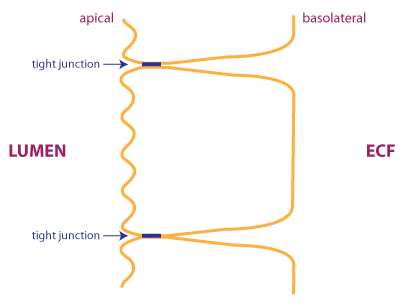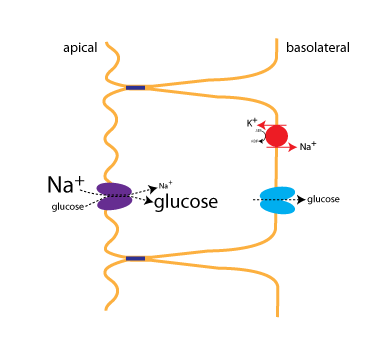Epithelial Transport
 Epithelia form linings
throughout the body. In the small intestine, for instance, the
simple columnar epithelium forms a barrier that separates
the lumen (inside of an
organ) from the internal environment of the body. (The internal
environment in which body cells exist is the extracellular fluid
or ECF). The
epithelium forms a barrier because cells are linked by tight junctions, which prevent
many substances from diffusing between adjacent cells. For a
substance to cross the epithelium, it must be transported across
the cell's plasma membranes by membrane transporters.
Epithelia form linings
throughout the body. In the small intestine, for instance, the
simple columnar epithelium forms a barrier that separates
the lumen (inside of an
organ) from the internal environment of the body. (The internal
environment in which body cells exist is the extracellular fluid
or ECF). The
epithelium forms a barrier because cells are linked by tight junctions, which prevent
many substances from diffusing between adjacent cells. For a
substance to cross the epithelium, it must be transported across
the cell's plasma membranes by membrane transporters.
Not only do tight junctions limit the flow of substances between
cells, they also define compartments in the plasma membrane.
The apical plasma membrane
faces the lumen. In the drawing, the apical plasma membrane
is drawn as a wavy line, because intestinal epithelial cells have
a high degree of apical plasma membrane folding to increase the
surface area available for membrane transport (these apical plasma
membrane folds are known as microvilli).
The
basolateral plasma membrane
faces the ECF. Epithelial cells are able to transport
substances in one direction across the epithelium because different
sets
of transporters are localized in either the apical or
basolateral membranes.
Absorption
 Absorption is the means
whereby nutrients such as glucose are taken into the body to
nourish cells. We are using glucose absorption as our specific
example; however other sugars and amino acids are absorbed using a
similar mechanism (but with different specific transporters).
Absorption is the means
whereby nutrients such as glucose are taken into the body to
nourish cells. We are using glucose absorption as our specific
example; however other sugars and amino acids are absorbed using a
similar mechanism (but with different specific transporters).
Glucose is transported across the apical plasma membrane of
intestinal epithelial cells by the sodium-glucose
cotransporter (SGLT,
purple protein in the figure at right). Transport via the
sodium-glucose cotransporter is referred to as secondary active transport because
transport depends upon the Na+ gradient (which is
established using the energy of ATP hydrolysis).
Just after a meal, there will be abundant glucose in the lumen of
the intestine, favoring absorption. Towards the end of the
absorptive phase of a meal, however, the cotransporter is still
able to move glucose into the cell (uphill against its
concentration gradient) because of the strong Na+
concentration gradient. This is what is depicted in the figure,
where the size of the type for Na+ and glucose
indicates their relative concentrations.
The Na+ gradient is established through active transport by the Na+/K+-ATPase
(red), which is located on the basolateral membrane. The activity
of the cotransporter increases the glucose concentration inside
the cells, allowing glucose to be transported into the ECF via the
glucose
transporter (GLUT,blue).
Facilitated diffusion of glucose into the ECF is a passive process, since glucose
flows down its concentration gradient.
Secretion
About 1500 ml of fluid per day is secreted into the lumen of the
small intestine in order to provide lubrication that can protect
the epithelium and help with intestinal motility. The mechanism
for fluid secretion is that solutes are first moved across the
epithelium, which then draw water into the lumen by osmosis.
The rate-limiting and regulated step
in intestinal secretion is the movement of Cl-
ions across the apical plasma membrane.
 The important proteins
involved in secretion are diagrammed in the figure. First, Cl-
is transported into the epithelial cell by a cotransporter (the
NKCC cotransporter) expressed
on the basolateral membrane. As with the previous example, the Na+
gradient, established by the Na+/K+-ATPase,
provides the energy to power transport of ions into the cell. The
NKCC cotransporter moves one Na+, one K+,
and 2 Cl- ions with each round of transport). Cl-
flows down its concentration gradient into the lumen via the CFTR (green), a Cl- channel
located on the apical plasma membrane. Not shown is
that Na+ also flows into the lumen, by a passive
mechanism.
The important proteins
involved in secretion are diagrammed in the figure. First, Cl-
is transported into the epithelial cell by a cotransporter (the
NKCC cotransporter) expressed
on the basolateral membrane. As with the previous example, the Na+
gradient, established by the Na+/K+-ATPase,
provides the energy to power transport of ions into the cell. The
NKCC cotransporter moves one Na+, one K+,
and 2 Cl- ions with each round of transport). Cl-
flows down its concentration gradient into the lumen via the CFTR (green), a Cl- channel
located on the apical plasma membrane. Not shown is
that Na+ also flows into the lumen, by a passive
mechanism.
Regulation of Secretion
The CFTR protein is a member of the ATP-binding
cassette (ABC) protein family. CFTR is an atypical
ABC protein; like other members of the ABC protein family, it
binds ATP, but in this case ATP binding is used to open an ion
channel. Importantly, the CFTR protein is also regulated by phophorylation: the protein
has a regulatory domain that must be phosphorylated
in order for the channel to open. Intestinal secretion is
turned on when a signaling molecule binds to a receptor that
through several steps causes the phosphorylation of CFTR. In
the disorder cholera, a
bacterial toxin blocks this signaling from turning off. The
result is that there is unregulated
intestinal secretion, causing very watery
diarrhea.
 Epithelia form linings
throughout the body. In the small intestine, for instance, the
simple columnar epithelium forms a barrier that separates
the lumen (inside of an
organ) from the internal environment of the body. (The internal
environment in which body cells exist is the extracellular fluid
or ECF). The
epithelium forms a barrier because cells are linked by tight junctions, which prevent
many substances from diffusing between adjacent cells. For a
substance to cross the epithelium, it must be transported across
the cell's plasma membranes by membrane transporters.
Epithelia form linings
throughout the body. In the small intestine, for instance, the
simple columnar epithelium forms a barrier that separates
the lumen (inside of an
organ) from the internal environment of the body. (The internal
environment in which body cells exist is the extracellular fluid
or ECF). The
epithelium forms a barrier because cells are linked by tight junctions, which prevent
many substances from diffusing between adjacent cells. For a
substance to cross the epithelium, it must be transported across
the cell's plasma membranes by membrane transporters. Absorption is the means
whereby nutrients such as glucose are taken into the body to
nourish cells. We are using glucose absorption as our specific
example; however other sugars and amino acids are absorbed using a
similar mechanism (but with different specific transporters).
Absorption is the means
whereby nutrients such as glucose are taken into the body to
nourish cells. We are using glucose absorption as our specific
example; however other sugars and amino acids are absorbed using a
similar mechanism (but with different specific transporters). The important proteins
involved in secretion are diagrammed in the figure. First, Cl-
is transported into the epithelial cell by a cotransporter (the
NKCC cotransporter) expressed
on the basolateral membrane. As with the previous example, the Na+
gradient, established by the Na+/K+-ATPase,
provides the energy to power transport of ions into the cell. The
NKCC cotransporter moves one Na+, one K+,
and 2 Cl- ions with each round of transport). Cl-
flows down its concentration gradient into the lumen via the CFTR (green), a Cl- channel
located on the apical plasma membrane. Not shown is
that Na+ also flows into the lumen, by a passive
mechanism.
The important proteins
involved in secretion are diagrammed in the figure. First, Cl-
is transported into the epithelial cell by a cotransporter (the
NKCC cotransporter) expressed
on the basolateral membrane. As with the previous example, the Na+
gradient, established by the Na+/K+-ATPase,
provides the energy to power transport of ions into the cell. The
NKCC cotransporter moves one Na+, one K+,
and 2 Cl- ions with each round of transport). Cl-
flows down its concentration gradient into the lumen via the CFTR (green), a Cl- channel
located on the apical plasma membrane. Not shown is
that Na+ also flows into the lumen, by a passive
mechanism.